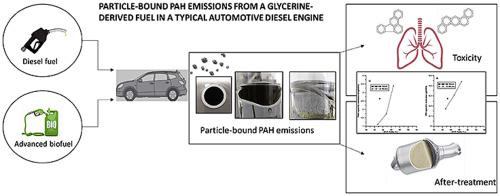Journal of the Energy Institute ( IF 5.6 ) Pub Date : 2020-04-24 , DOI: 10.1016/j.joei.2020.04.012 Rosario Ballesteros , Ángel Ramos , Jesús Sánchez-Valdepeñas

|
Polynuclear or polycyclic aromatic hydrocarbons (PAH) are known to be one of the most dangerous types of compounds of their class due to their carcinogenic potential. Some atmospheric PAH are measured and regulated to quantify the air quality. However, in order to better understand the presence of these compounds in the atmosphere it is crucial to study the PAH emissions sources. In this work, we analyze the particulate-bound PAH emissions, as well as their carcinogenic potential, from a typical baseline diesel engine using a promising alternative fuel obtained from the glycerol surplus in the biodiesel production industry. This advanced biofuel (Mo.bio) is a ternary mixture of residual glycerine-derived fuel (FAGE), a conventional fatty acid methyl ester (FAME) and a diesel fuel. Two operating conditions representative of the conflicting scenarios when studying polluting emissions (speeds of 50 km/h and 70 km/h typical of urban and extra-urban driving conditions) are used. In addition, with the purpose of deepening the understanding of the behavior of this new fuel, tests are carried out modifying the Exhaust Gas Recirculation (EGR) ratio. The PAH samples are collected before the aftertreatment systems in order to assess the possible formation of PAH with this type of fuel and to evaluate the options of the aftertreatment devices. Sampling is carried out using fiber-glass filters, extracting the trapped PAH using Soxhlet method. The analytical procedure (liquid chromatography with fluorescence detection) allows to appreciate differences between the different fuels and modes of operation, observing higher emissions of benzo[a]pyrene (BaP) and dibenz[a,h]anthracene (DahA) for the diesel fuel than for the mixture containing residual glycerine-derived fuel. Therefore, it is concluded that the fossil fuel has a larger carcinogenic potential in these conditions, and that the Mo.Bio fuel may possibly expand the EGR ratio range without increasing the requirement of the particle filter.
中文翻译:

典型的汽车柴油发动机中甘油废燃料混合物产生的微粒结合的PAH排放
多核或多环芳族烃(PAH)由于其致癌潜力,是同类化合物中最危险的类型之一。对某些大气中的PAH进行测量和调节以量化空气质量。但是,为了更好地了解大气中这些化合物的存在,研究PAH排放源至关重要。在这项工作中,我们使用典型的基准柴油发动机,使用从生物柴油生产行业中甘油过剩中获得的有前途的替代燃料,分析了颗粒结合的PAH排放及其致癌潜力。这种先进的生物燃料(Mo.bio)是残留的甘油衍生燃料(FAGE),常规脂肪酸甲酯(FAME)和柴油燃料的三元混合物。在研究污染排放时,使用了两种代表冲突情景的运行条件(典型的城市和城市外行驶条件时速为50 km / h和70 km / h)。另外,为了加深对这种新燃料的性能的了解,进行了一些试验以改变废气再循环(EGR)比。在后处理系统之前收集PAH样品,以评估使用这种类型的燃料可能形成的PAH,并评估后处理设备的选项。使用玻璃纤维过滤器进行采样,使用索氏提取法提取捕获的PAH。分析程序(具有荧光检测功能的液相色谱法)可让您了解不同燃料和运行方式之间的差异,观察到,与含有残留甘油衍生燃料的混合物相比,柴油燃料中苯并[a] py(BaP)和苯并[a,h]蒽(DahA)的排放量更高。因此,可以得出结论,在这些条件下,化石燃料具有更大的致癌潜力,并且钼生物燃料可能会在不增加颗粒过滤器需求的情况下扩大EGR比范围。











































 京公网安备 11010802027423号
京公网安备 11010802027423号